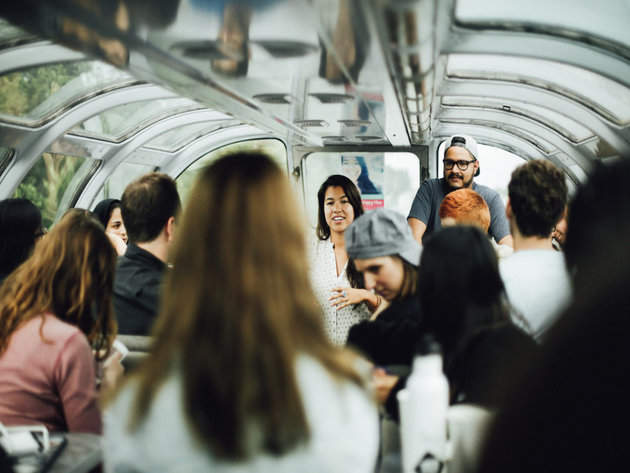
In August, a team of innovators began a 3,000km journey between Pittsburgh, Chicago, Kansas City, Albuquerque and Los Angeles. Inside vintage train cars, a work station fully equipped with state-of-the-art computers, 3D printers, 3D scanners – and a 3D-printed electric guitar – is used as an incubator for social, economic and cultural development projects.
Of this year’s projects, two rail-oriented ventures that stand out come from Rachel Reilly Carroll, associate director at Enterprise Community Partners, and Danya Sherman, urban planner at the Massachusetts Institute of Technology (MIT).

Discover B2B Marketing That Performs
Combine business intelligence and editorial excellence to reach engaged professionals across 36 leading media platforms.
Carroll is using her journey to explore how new transit infrastructure projects can lead to the displacement of low-income and working families across the US, while Sherman sets out to develop cultural initiatives on and around the US rail network.
Equitable transit: Rachel Reilly Carroll
In each city, Carroll is visiting the ’ground zero’ for new or upcoming transport infrastructure projects and speaking to the developers and authorities in charge, but also with the residents living in the neighbourhoods affected by the construction.
“I’m looking at affordable housing policies to see whether these are in place to protect opportunities for people on low or moderate incomes to remain living in the area,” Carroll explains.
Over the past few years, a resurgent interest in the urban lifestyle has seen many more people moving into the city. This social movement often comes at the expense of people from poorer backgrounds, who are pushed out of the gentrified neighbourhoods.

US Tariffs are shifting - will you react or anticipate?
Don’t let policy changes catch you off guard. Stay proactive with real-time data and expert analysis.
By GlobalDataNew public transport networks such as rail, tube and tram lines are a leading contributing factor to this problem, particularly in areas previously known as ’transit deserts’.
“The way that cities are planning and making these transit investments will have real consequences and I think that large public infrastructure projects tend to be the most impactful,” says Carroll.
Through her organisation, she is championing a concept called equitable transit oriented development (ETOD), which looks at the best practices cities or transit agencies can use, including land use policies and different types of lending funds that can preserve affordable housing around future transit corridors.
“The US Department of Transportation is a big funder of a lot of these projects and they’ve been really progressive in their view of wanting to make equity a goal,” Carroll says. “The Secretary for Transportation [Anthony R Foxx] has been a huge proponent of the ETOD movement.”
During the 2016 US election campaign, both housing and transportation have taken centre stage as issues voters care about. A poll organised by the Make Room campaign in July showed that 76% of voters would be more likely to support a candidate who made housing affordability a focus of their campaign.
“There are a lot of great opportunities and a number of ways to intervene and to start planning now, it’s just about acknowledging that this is a problem,” Carroll says.
“Being able to visit five cities in seven days is such a unique opportunity, being able to go from city to city in such a short amount of time and really highlight that this is a problem, not only in major cities, but also in mid-sized cities throughout the country.
“It’s really applicable across America.”
Engines of culture: Danya Sherman
Sherman’s project explores culture on trains, as well as of train riders.
“I would like to develop cultural initiatives,” she says. “Ideas range from a design-build train, to artist residencies, to advocacy tools and more, that take better advantage of the US train network, particularly its long-distance routes.”
Her interest in the intersection between train travel and culture began in 2014 as research for her master’s thesis in urban planning at MIT, when Sherman bought a 30-day rail pass and rode through 22 states around the country, documenting her journey along the way.
“I think that train travel is an incredible lens through which to understand several key aspects of US culture,” she explains. “The research I’ve done indicates that people are having unique, meaningful humanistic experiences on long-distance trains.”
Sherman adds that: “The cultural critic Michel Foucault coined a term called ‘heterotopia’ to describe spaces that function both inside and outside normal societal spaces, giving people an opening to create new social rules.”
Inspired by her findings, Sherman founded the public programming, education and community engagement department on New York City’s High Line, a public park built on a historic freight rail line elevated above the streets on Manhattan’s West Side.
“Individually, I observed that the train space is very meditative, generative and inspiring. Socially, the observation cars – or lounge cars – on long-distance routes become almost like cafes, where people meet each other, talk in unusually open ways often across age, ethnic and other barriers that might normally separate them.”
During her MTP journey, Sherman hopes to solidify a business plan for an organisation that builds culture on trains and a culture of train riders – a ’big idea for a big country’ that will benefit from the five-day discussion with the other participants.
“I am excited about being with a cohort of like-minded, ambitious do-ers so we can help each other move our projects forward, and benefit from the mentors onboard.”
Sherman says her ultimate goal is to “develop an organisation that commissions and curates arts and cultural activities on America’s underutilised passenger rail network, and partner with national transportation advocacy groups to build awareness and support for national rail infrastructure.”





